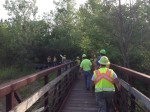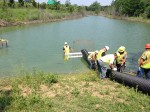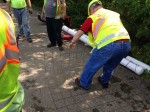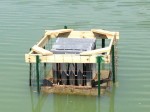
 Beavers set up home in downtown Napa
Beavers set up home in downtown Napa
Downtown has some new residents, and they’re not the two-legged tourist variety. Beavers have moved into Napa Creek and built at least two dams visible from the Pearl Street pedestrian bridge and from the parking lot behind the former Napa Firefighters Museum.
“I think it’s great. It speaks to the health of the watershed,” said Shaun Horne, watershed and flood control resource specialist for the Napa County Flood Control and Water Conservation District.
“It’s a good sign for the creek,” Horne said. “The whole beaver population seems to be spreading. These creatures are recolonizing some of these areas that maybe didn’t have the best habitat prior to this.”
Beavers change creek hydrology for the better, Horne said. Dams pool water, which is good for fish, birds and other wildlife. Beaver dams can also help reverse channel deepening, provide nurseries for fish, increase habitat for small mammals, contribute to the establishment of new vegetation and improve downstream water quality by trapping sediment.
Napan Rusty Cohn is a regular beaver watcher. He’s seen the animals and their work at Tulocay Creek near Soscol Avenue and other river areas in the city. He gave the new dam on Napa Creek a thumbs-up.
“They did a nice job of building it,” Cohn said. He has yet to spot the downtown beavers, but he has a theory about where they came from.
More remarkable beaver wisdom from Napatopia, with Flood control saying how valuable beavers are and Rusty getting some smart quotes in. I can’t figure out thought why they didn’t run some of his great photos, or the news that there are three new kits in Tulocay creek. Reporters remain a mystery to me, but you are encouraged to solve the puzzle for yourself.
More good news from places that aren’t here. Brace yourself. This is surprising. The state of Ohio (OHIO?) Department of Transportation has apparently contracted with Mike Callahan to teach them to install flow devices to control beaver damming rather than killing them Here is proof they’re listening.
A Possible Beaver First!
Last week in Cincinnati the Ohio Dept. of Transportation hired me to train their personnel how to manage beaver problems with flow devices. Is anyone aware of another state Highway Dept. that has committed to building and installing flow devices themselves? I think Ohio may be the first! Here in Massachusetts the MassDOT is very supportive of flow devices but they contract with me to install them. Ohio wants to start doing flow devices themselves which I think is pretty cool!
All this came about due to local beaver advocate Karen Arnett being persistent and lobbying the ODOT to consider flow devices as an alternative to trapping. Her dogged efforts bore fruit and the beavers, humans and ecosystems of Ohio are bound to benefit.
The ODOT training included a PowerPoint presentation tailored to ODOT needs, and a hands-on flow device installation where many ODOT staff participated. The flow device install site is a highway retention pond where unfortunately beavers were trapped last year. Since new beavers are bound to relocate here ODOT wanted a flow device to protect the drainage structure and prevent the need to trap in the future. I was very impressed with the level of interest by ODOT staff and their willingness not only to do the work but also get in the water. See pictures. Kudos to ODOT as well as to Karen for getting ODOT interested in flow devices!
Karen contacted this website ages ago, and Beavers: Wetlands and Wildlife as well. She really did a stellar job of getting new ideas through thick skulls. And Mike did a great job convincing them once she got their attention. Great work team beaver!


















































